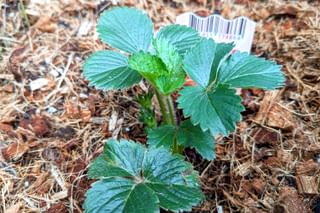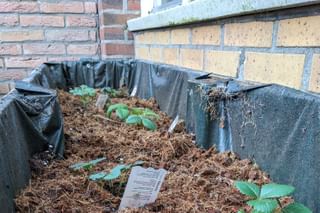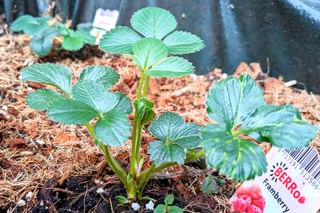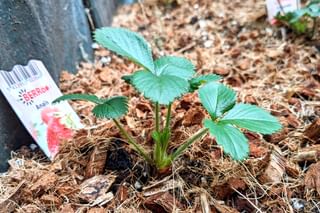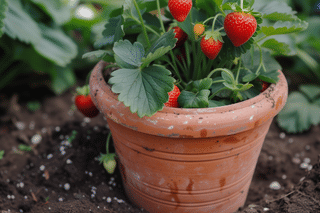How to Grow Strawberries in Your Garden
Discover how to grow juicy, sweet strawberries right in your backyard with our comprehensive guide! Learn step-by-step, from soil preparation to harvesting, how to care for these delightful fruits. Perfect for beginners craving a taste of homegrown goodness.
From strawberry shortcakes to fresh summer salads, strawberries are an amazing fruit for many different occasions. Imagine being able to pluck them straight from your garden, knowing they're free from the pesticides and waxes of store-bought berries.
It's easier than you might think to grow strawberries at home, and with a little bit of patience and care you'll have nice fruits to harvest in the summer. Follow these straightforward steps to ensure your strawberries thrive in your garden patch.
What are you waiting for? Let's get started and learn how to grow strawberries in your garden!
Step 1: Choosing the right location
Selecting the right spot is crucial to the success of your strawberry plants. Strawberries love the sun, so pick an area that receives at least 6-8 hours of direct sunlight per day. Ensure the soil drains well, as strawberries do not like their roots to sit in water.
How to choose the perfect spot for strawberries
- On a bright day, walk through your garden to find the sunniest spots. These spots are perfect for growing strawberries.
- Next, wait until there is rain and see how well the soil drains. If there is a lot of standing water that doesn't seem to drain into the soil, you'll have to pick a different spot or be prepared to do some work to improve drainage. If you plan on growing strawberries in pots, you can skip this step.
- For the best chance of success, consider planting your strawberry plants near a south-facing fence or wall to get maximum sun exposure and to create a microclimate that retains heat, which strawberries also enjoy.
Moist, well-draining soil, heat, and plenty of direct sunlight create the perfect spot for growing your strawberries. If you don't have a spot like this, you can always choose to grow your strawberries in a pot. This might give you more flexibility to still grow strawberries successfully.
Step 2: When to plant the strawberry plant
Knowing the right time to plant is essential for a good strawberry harvest. Different varieties of strawberries should be planted at different times.
Here's a table of some of the most common strawberries, when you should plant them, and when you can expect to harvest them.
| Strawberry Variety | Planting Time | Expected Harvest Time |
|---|---|---|
| Chandler (June-Bearing) | March to May | Late Spring to Early Summer (following year) |
| Sequoia (Ever-Bearing) | April or late summer | Summer and Fall (same year) |
| Albion (Day-Neutral) | April or late summer | Spring to Fall (same year) |
| Honeoye (June-Bearing) | March to May | Early to Mid-Summer (following year) |
| Ozark Beauty (Ever-Bearing) | April or late summer | Summer and Fall (same year) |
Planting and harvest times can differ based on where you live, so for the most accurate planting and harvesting times, I recommend consulting a local nursery or gardening expert for advice tailored to your area!
On average, you can start to plant most strawberry plants in March or April and they should result in delicious strawberries in July or August.
Step 3: Preparing the soil
Now that you know when to plant your strawberries, let's have a look at preparing the soil. In the section about finding the right spot to grow your strawberries, I quickly mentioned that you might need to do a little work to prepare the soil.
This has 2 reasons: the soil must drain excess water well and strawberries like slightly acidic soil with a pH between 5.5 and 7.0. It's essential to prepare the soil before planting to provide a healthy foundation for your berries.
Making the soil drain well
If your soil isn't draining well at the moment, you should amend it with perlite and coconut husks/fibers. These ingredients are perfect for keeping the soil light and airy, while also helping it hold onto some moisture for your strawberry plants to absorb. This mixture will drain most excess water away from your plants.
If you have clay fairly close to the soil, like me, you might have to start digging and replacing some of it with the amended soil for the best result. Once your soil drains well, you can start to look at making it slightly acidic.
Making the soil slightly acidic
Making the soil slightly acidic takes a few steps:
- Perform a soil test to determine the pH level. You can often get these tests done for free or at a low cost from local agricultural extension services.
- If your soil is too alkaline, lower the pH by mixing in elemental sulfur or another acidic amendment. If it's too acidic, add some lime.
- Work plenty of organic matter, like compost or well-rotted manure, into the soil to improve its fertility. This will also help with drainage.
Make sure to regularly test the soil to check if the growing conditions are still optimal for your strawberries. Testing this once per year is usually plenty.
When the soil drains well and is ready for strawberries, you can go ahead and plant them!
Step 4: Planting the strawberries
Now that we've found the perfect sunny spot and prepared our soil, it's time to get those strawberry plants into the ground. For me, this is the most exciting part of plant care, so I'm very excited to help you with this part!
Planting tips
To give your strawberries the best chance of success, I've got 3 essential tips for you that you should use when planting:
- Set your strawberry plants in the ground so that the crown (where the leaves emerge) is level with the soil surface. Planting too deep can cause rot and fungal infections.
- Space your strawberry plants about 12 to 18 inches apart in rows that are 2 to 3 feet apart to give them room to multiply. These plants are going to grow many air roots, so make sure to not overcrowd them while planting them. They will fill in the gaps themselves.
- Water the newly planted strawberries thoroughly to help them settle, but avoid soaking the soil.
- If you grow multiple different types of strawberries, make sure to label them. You will forget which plant is which, speaking from experience.
Now that you've planted your strawberries in the perfect spot, the "hard work" begins. Now you'll need to maintain these plants until they start to give your fruit. Let's see how!
Step 5: Maintenance and care
Strawberries, those easy-to-care-for gems, really shine when you regularly give them a bit of love. Just keep them watered, give them good soil, and trim them regularly and they'll be happy. So how do you take care of them best? Let's see!
How to help your strawberries thrive
- Water your strawberry plants when the top of the soil has dried out. Make sure to keep rainfall in mind. Consistent moisture is very important for these plants, they can't dry out at all. During the flowering and fruiting season, they'll need lots of moisture to grow their fruit.
- For the perennial strawberry plants, you should fertilize them with a balanced fertilizer in the spring when growth starts and again after the last fruiting. This way they'll be ready to go again the following year.
- Keep weeds at bay. They compete with your strawberries for water and nutrients.
- One of the biggest problems is pests like slugs, snails, and birds. Protective covers can help keep birds at bay, and traps or diatomaceous earth can fend off slugs and snails. A mulch layer of coconut husks also does wonders against slugs.
The time between planting your strawberry plants and harvesting them is for most types of strawberries only a few months. During this time you'll need to regularly check if your plants need any water or perhaps more protection from pests.
Step 6: Harvesting
And then, the moment you've been waiting for! The harvest of your strawberry plants! This moment is what you've been working for for months.
Depending on the variety, strawberries will ripen between four to six weeks after blooming in the spring or summer. Most strawberries will be ready for harvesting in July or August, right on time for the hottest time of year.
Knowing when to pick your strawberries
But when do you know your strawberries are ready to be plucked? When they're a deep red color! Strawberries won't continue riping after you've harvested them, so make sure to wait until they're ready!
Harvesting tips
When they're ready, this is how you can harvest them:
- Gently twist the berries to pick them, leaving the stem intact. If you have to tug, they're not ready to be picked.
- Harvest strawberries in the morning when it's cool, and they're full of moisture. This makes for sweeter, juicier berries.
When you've picked them, make sure to rinse them off to remove any dirt and eat them as quickly as possible. You can keep them in the fridge for a few days, but they're best when you pick them.
Conclusion
Growing strawberries in your garden is such a fulfilling and rewarding experience! Just follow these simple instructions and give a little tender loving care, and you'll soon be enjoying the delicious harvest of your homegrown strawberries. Remember, patience is key; your first harvest might be small, but each year, your patch will yield more as the plants grow.
Thank you for reading this post! I hope it helps you to keep your plants healthy and beautiful! If you're looking for more guides on specific plants, you can always request a plant guide to get a guide for the plant you have trouble with.
Test your plant care knowledge
Quiz completed!
Want to learn more? Sign up for my newsletter to receive free tips in your inbox!
Sign up now!